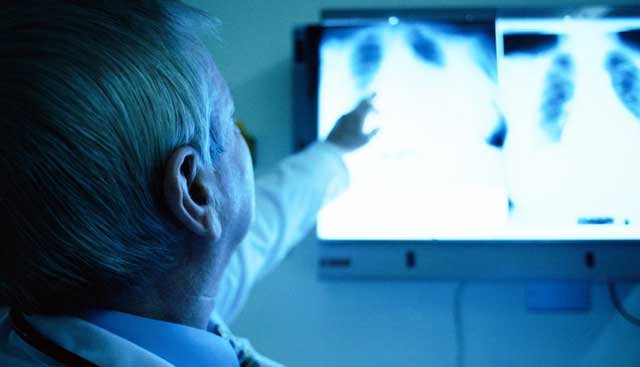Mesothelioma Diagnosis

If the chest x-ray is suggestive of malignant mesothelioma, it is likely that further investigations will be ordered, especially if compensation may be sought.
These investigations may include additional imaging studies, blood tests, bone scans, and lung-function tests, as well as more invasive procedures such as thoracentesis, thoracoscopy, pleuroscopy or a lung biopsy. This is a typical mesothelioma diagnosis
Mesothelioma diagnosis can be done through chest x-ray. The typical abnormalities seen on chest x-ray in patients with malignant mesohtelioma are pleural effusion (a collection of fluid in the space between the 2 layers of the pleura), or it is called pleural thickening.
Unlike lung cancer, there is no association between mesothelioma and smoking Malignancies involving mesothelial cells in these spread cavities are known as malignant mesothelioma, which may be localized or diffuse. Mesothelioma is the word used to describe a cancerous tumor that involves the mesothelial cells of an organ, often the lungs, heart, or abdominal organs.
Mesothelioma diagnosis in this disease, malignant cells develop in the mesothelium, a protective lining that covers transcendently of the spread's internal organs. Greatest malignant mesothelioma set up complex karyotypes, with extensive aneuploidy and rearrangement of tons chromosomes.
Symptoms of mesothelioma may not appear until 20 to 50 years after exposure to asbestos. Mesothelioma diagnosis is often difficult, because the symptoms are similar to those of a number of other conditions. A history of exposure to asbestos may increase clinical suspicion for mesothelioma.
A physical examination is performed, followed by chest X-ray and often lung function tests. The X-ray may reveal pleural thickening commonly seen after asbestos exposure if mesothelioma diagnosis is done.
If the cancer has length beyond the mesothelium to other parts of the size, symptoms may include pain, trouble swallowing, or swelling of the neck or engage.
Symptoms of peritoneal mesothelioma include weight loss and cachexia, abdominal swelling and suffering due to ascites (a buildup of fluid in the abdominal cavity).
Exposure to airborne asbestos particles increases one's risk of developing malignant mesothelioma.
Mesothelioma diagnosis of malignant mesothelioma has a peak incidence 35-45 years after asbestos exposure. Malignant mesothelioma is a rare type of cancer in which malignant cells are found in the sac lining the chest or abdomen. Most people with malignant mesothelioma have on worked on jobs where they breathed asbestos.
It can also occur in children; however, these cases are not thought to be associated with asbestos exposure.
Most people who develop mesothelioma get worked on jobs where they inhaled asbestos particles, or have been exposed to asbestos dust and fiber in other ways, such as by washing the clothes of a family member who worked with asbestos, or by home renovation using asbestos cement products.
Treatment options a mesothelioma diagnosis for the management of malignant mesothelioma includes surgery, chemotherapy, radiation, and multimodality treatment. Surgery in victims with disease confined to the pleural space is reasonable.
Extrapleural pneumonectomy is a more extensive procedure and has a higher mortality rate. Recently, the mortality rate has been lowered to 3.8%. It involves dissection of the parietal pleura; division of the pulmonary vessels; and en bloc resection of the lung, pleura, pericardium, and diaphragm followed by reconstruction. It provides the greatest local control because it removes the entire pleural sac along with the lung parenchyma.
The 2 surgical procedures used are pleurectomy with decortication and extrapleural pneumonectomy.
Surgical resection has been relied upon because radiation and chemotherapy get hold of been ineffective unequivocal treatments. There are now a number of cancer treatment options open to mesothelioma patients. Extrapleural pneumonectomy for selected victims with very early stage disease may expand recurrence-free survival, but the impact it has on overall survival is unknown at this time.
Mesothelioma diagnosis can be intimidating and can scare a lot of people, but mesothelioma diagnosis may give you a fighting chance if can be diagnose early. So do yourself a favor if you think that what you are suffering from and had worked in an asbestos related workplace.
The purpose of such investigations in mesothelioma diagnosis is to confirm and to determine the type of mesothelioma, to 'stage' the disease (measure how severe it is), and so to assess whether the disease is operable.